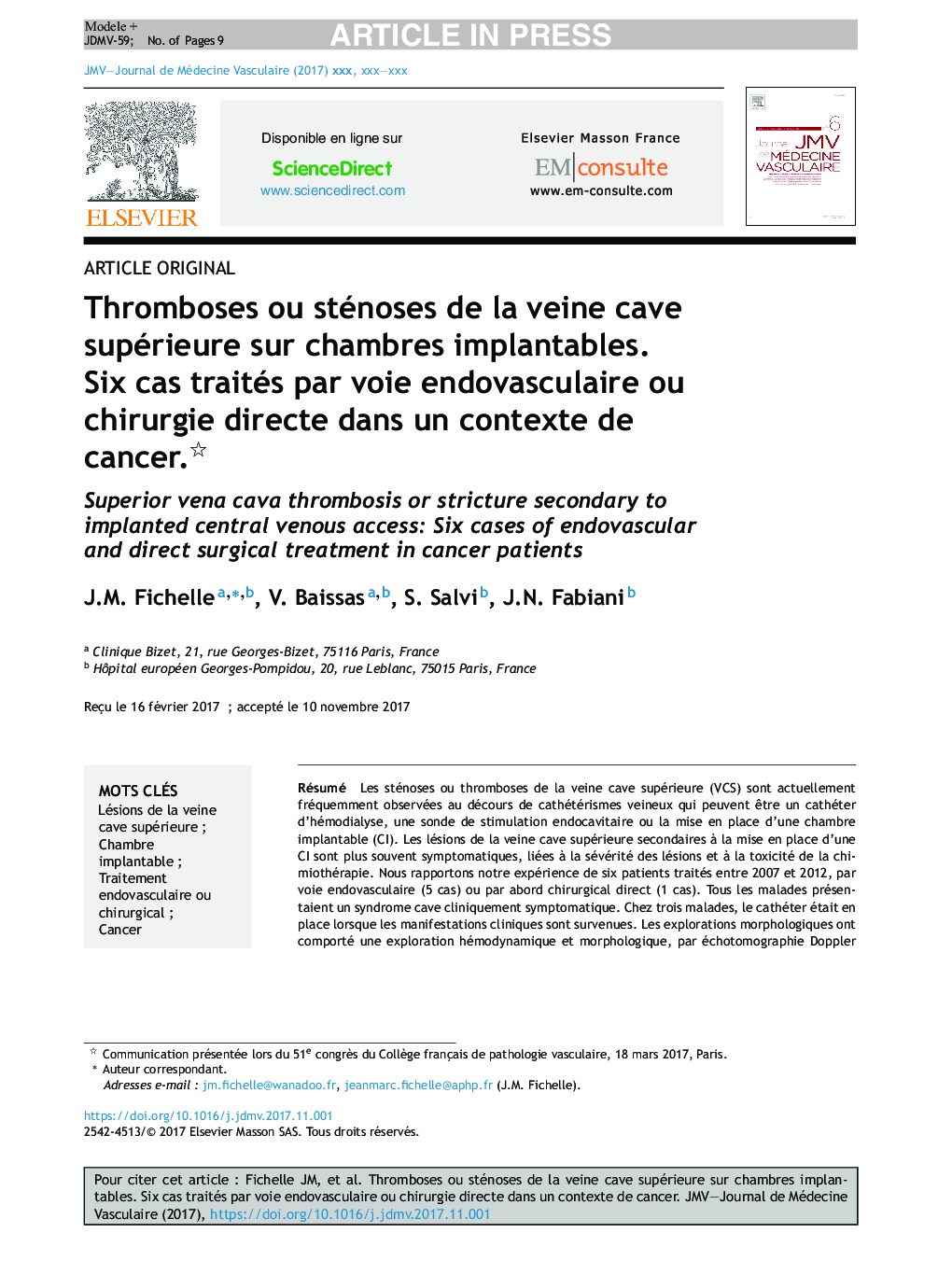| کد مقاله | کد نشریه | سال انتشار | مقاله انگلیسی | نسخه تمام متن |
|---|---|---|---|---|
| 8924245 | 1643533 | 2018 | 9 صفحه PDF | دانلود رایگان |
عنوان انگلیسی مقاله ISI
Thromboses ou sténoses de la veine cave supérieure sur chambres implantables. Six cas traités par voie endovasculaire ou chirurgie directe dans un contexte de cancer.
دانلود مقاله + سفارش ترجمه
دانلود مقاله ISI انگلیسی
رایگان برای ایرانیان
کلمات کلیدی
موضوعات مرتبط
علوم پزشکی و سلامت
پزشکی و دندانپزشکی
کاردیولوژی و پزشکی قلب و عروق
پیش نمایش صفحه اول مقاله

چکیده انگلیسی
Superior vena cava (SVC) stenosis or thrombosis is a well-known complication of central venous catheterization for endocavitary treatments, hemodialysis, or chemotherapy. In cancer patients, these SVC lesions are often symptomatic due to intimal damage and chemotherapy toxicity. We report our experience with six patients treated between 2007 and 2012 via an endovascular approach (n = 5) or a direct surgical approach (n = 1). All patients had SVC syndrome with facial edema, headache and upper limb edema. In three cases, the catheter was in place when the clinical symptoms occurred. Duplex Doppler and computed tomography (CT)-angiography identified the following lesions: isolated SVC stenosis (n = 2); SVC stenosis with right Pirogoff confluence stenosis (n = 1); SVC stenosis associated with left innominate vein thrombosis and right Pirogoff confluence stenosis (n = 1); SVC thrombosis affecting azygos flow (n = 2). In one patient, the thrombus extended into the right atrium. Five patients underwent endovascular repair via a right jugular approach (n = 2) or a double jugular approach (n = 3). Treatment involved: SVC angioplasty with stent (n = 2); right Pirogoff angioplasty and SVC stent (n = 1); kissing angioplasty of both innominate trunks with a SVC stent (n = 1); and SVC angioplasty without stent because of an incomplete result with a residual lumen less than 8 mm (n = 1). One patient had a complete SVC occlusion with extension of thrombus into the right atrium. She was treated via a median sternotomy for open surgical control of both innominate trunks and lateral clamping of the right atrium. A long cavotomy prolonged on the right atrium allowed thrombo-intimectomy and pericardial patch angioplasty. Postoperative follow-up was uneventful in five cases. However, postoperative hemorrhage required pericardial drainage in one patient. The CT scan showed a good morphological aspect in five patients and an incomplete result in one case. Patients have been followed up annually with a duplex scan from two to six years. One patient had a restenosis at 7 months treated by a new angioplasty via a femoral approach. A new catheter was positioned via a cervical approach. Two patients died of metastatic diffusion at 8 and 32 months. The other four patients have remained asymptomatic, with a satisfactory duplex scan. In conclusion, VCS lesions after implanted central access for chemotherapy can often be treated endovascularly. Conventional surgery still has indications when lesions extend into the right atrium.
ناشر
Database: Elsevier - ScienceDirect (ساینس دایرکت)
Journal: JMV-Journal de Médecine Vasculaire - Volume 43, Issue 1, February 2018, Pages 20-28
Journal: JMV-Journal de Médecine Vasculaire - Volume 43, Issue 1, February 2018, Pages 20-28
نویسندگان
J.M. Fichelle, V. Baissas, S. Salvi, J.N. Fabiani,